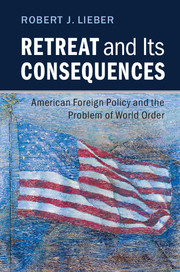Book contents
- Frontmatter
- Dedication
- Contents
- List of figures and tables
- Acknowledgments
- Introduction
- 1 Foreign policy retreat and the problem of world order
- 2 Burden sharing with Europe: problems of capability and will
- 3 Middle East policy: regional conflicts and threats to national interest
- 4 BRICS: stakeholders or free-riders?
- 5 Retreat and its consequences
- 6 Can America still lead – and should it?
- Index
6 - Can America still lead – and should it?
Published online by Cambridge University Press: 05 May 2016
- Frontmatter
- Dedication
- Contents
- List of figures and tables
- Acknowledgments
- Introduction
- 1 Foreign policy retreat and the problem of world order
- 2 Burden sharing with Europe: problems of capability and will
- 3 Middle East policy: regional conflicts and threats to national interest
- 4 BRICS: stakeholders or free-riders?
- 5 Retreat and its consequences
- 6 Can America still lead – and should it?
- Index
Summary
No major issue of world peace and stability can be resolved without US leadership.
– Lee Kwan YewThe foreign policy role of the United States matters greatly, not just for the prosperity and security of the country itself, but for the safety and security of America's allies and the future of global order. We tend to take for granted the institutions and rules of the road through which relations among nations take place, but these have been a product of the post–World War II international order largely created by American leadership in cooperation with wartime allies. It is thus fitting that a high ranking participant in these endeavors, Dean Acheson, who served as Under Secretary and then Secretary of State from 1949 to 1953, could entitle his memoir of that era, Present at the Creation. Not only are the institutions such as the United Nations, International Monetary Fund, World Bank, NATO, European Union, World Trade Organization, International Court of Justice, World Health Organization, a direct or indirect product of that era, but so too are key elements of international law and the conduct of state to state relations involving sovereignty, territorial integrity, nonintervention, trade, travel, investment, and the principles (if not the observance) of human rights.
CRISES AND RESILIENCE
The viability as well as the desirability of America's leading international role came into question as early as the 1970s. As noted in Chapter 4, President Richard Nixon and his National Security Advisor (and later Secretary of State)Henry Kissinger saw a need to adapt to a growing diffusion of power in the international system. The changes they identified included the postwar recovery of the Soviet Union with its formidable conventional and nuclear military power, the rejuvenation of the Europeans and Japan from the devastation of World War II and their appearance as major economic competitors to the United States, and the emergence of major regional powers in Asia, Africa, and Latin America. At the same time Nixon and Kissinger sought a means to disengage credibly from the Vietnam War and to mitigate the conflict with the Soviet Union through the policy of detente.
The United States had led the Western world since 1945, underwriting economic recovery, the NATO alliance, and geopolitical containment of the Soviet Union that allowed the industrial democracies to thrive as never before.
- Type
- Chapter
- Information
- Retreat and its ConsequencesAmerican Foreign Policy and the Problem of World Order, pp. 112 - 138Publisher: Cambridge University PressPrint publication year: 2016



